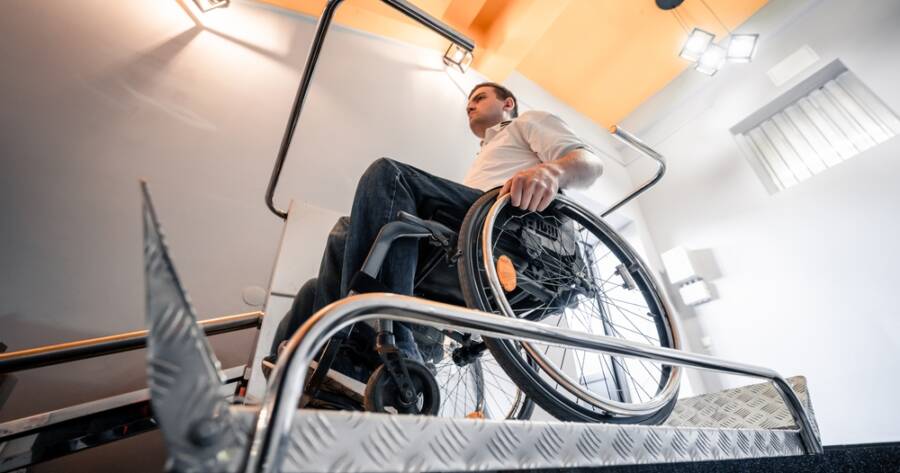As people age, mobility challenges can make everyday activities, such as going up and down stairs, increasingly difficult. For many seniors, stairlifts have been a go-to solution for maintaining independence and staying in their homes longer. However, advancements in technology have led to the development of new stairlift alternatives in 2025, offering even more choices for seniors who need assistance with climbing stairs. These alternatives provide the same benefits as traditional stairlifts but come with added flexibility, ease of use, and, in some cases, a more affordable price. Explore some of these exciting new options that are impressing seniors and transforming the way they navigate their homes.
1. Vertical Platform Lifts (VPLs)
Vertical platform lifts, also known as VPLs, are becoming a popular choice among seniors looking for stairlift alternatives. Unlike traditional stairlifts that require riders to remain seated, VPLs provide a platform that can accommodate wheelchairs or walkers, making them an excellent option for seniors with severe mobility impairments or those who use mobility devices. These lifts can be installed both indoors and outdoors, providing easy access between floors in a home or even for outdoor areas like decks.
What makes VPLs particularly appealing is their versatility. Seniors can roll on and off the lift from a seated or standing position, and the lift can carry larger items, such as groceries or furniture, making it more functional than a traditional stairlift. In 2025, new VPL models come with modern features such as smoother operation, quieter motors, and enhanced safety features like automatic stop functions, ensuring a more comfortable and secure experience.
2. Home Elevators
Another innovative stairlift alternative that is gaining popularity in 2025 is the residential home elevator. These elevators are more compact and affordable than traditional commercial elevators, making them a viable option for residential properties. A home elevator can be installed in a way that seamlessly integrates into a home’s design, offering both aesthetic appeal and practical functionality.
Home elevators are particularly suitable for those who want long-term mobility solutions, as they can accommodate a range of physical disabilities and allow for easier transport of people and goods between floors. Many modern home elevators are designed to be energy-efficient, and some even operate on rechargeable batteries, providing extra reliability in the event of power outages.
3. Stair-Climbing Wheelchairs
For seniors who don’t want to invest in a traditional stairlift or don’t have the space for a bulky installation, stair-climbing wheelchairs are another alternative making waves in 2025. These innovative wheelchairs are specifically designed to safely navigate stairs. Equipped with tracks or caterpillar-like wheels, they can climb stairs effortlessly, allowing users to remain seated and feel secure while ascending or descending.
These stair-climbing wheelchairs are highly versatile, lightweight, and often come with easy-to-use controls. They can be used on a variety of stair types, from straight to curved, making them a great solution for homes with different layouts. Although they require assistance from a caregiver or family member, these wheelchairs can greatly enhance mobility and independence for seniors in multi-story homes.
4. Inclined Lifts for Wheelchairs
Inclined lifts are a newer solution that has become increasingly popular in recent years as a stairlift alternative. Unlike vertical lifts or traditional stairlifts, inclined lifts allow users to ride along a track that follows the incline of the stairs. These lifts are often designed for wheelchair users, but they can also accommodate people with other mobility devices like walkers.
These inclined lifts take up less space than traditional stairlifts and can be customized to fit a variety of stair configurations. They operate on a gentle incline, providing a smooth and safe ride. The ease of installation and lower maintenance costs make inclined lifts a more affordable option compared to traditional home elevators.
5. Automated Mobility Solutions
As technology advances, there are now automated mobility solutions designed specifically for seniors that offer a more hands-off approach to mobility assistance. In 2025, seniors can access smart home systems that work in tandem with mobility devices to automatically adjust to their needs. For example, some systems allow users to control a lift or elevator with voice commands, making it easier for seniors to navigate stairs without the need for complicated controls.
Additionally, these automated systems can be integrated with home security features, offering both convenience and peace of mind. For seniors who may have difficulty operating mechanical systems or require more intuitive options, these technological solutions provide an easy and accessible way to navigate their living spaces.
Embrace the Future of Mobility with 2025’s Stairlift Alternatives
With the growing demand for solutions that improve seniors’ mobility and independence, the stairlift alternatives available in 2025 are nothing short of impressive. From vertical platform lifts and home elevators to stair-climbing wheelchairs and inclined lifts, these alternatives offer flexibility, convenience, and safety for seniors who want to stay in their homes longer. Whether seeking a solution that accommodates mobility devices, adds elegance to the home, or is a budget-friendly option, seniors now have a range of choices to help them live more comfortably and securely. As technology continues to evolve, the future of senior mobility will only improve, offering even more options for those who want to maintain their independence.

